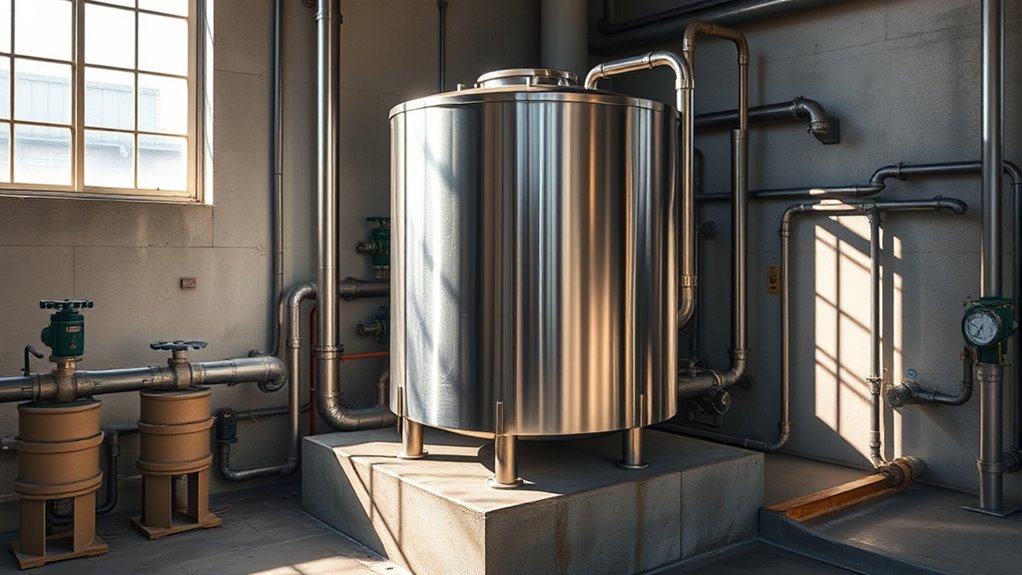A surge tank helps you control pressure changes in fluid systems by absorbing sudden flow variations and preventing water hammer damage. Proper placement involves situating it near pumps or high-pressure zones, while sizing depends on flow rates and pressure fluctuations to guarantee it handles surges effectively. Choosing the right type and design also plays a role in system safety and reliability. To optimize performance, consider the key factors involved—more details await if you keep exploring.
Key Takeaways
- Surge tanks absorb pressure and flow fluctuations to prevent damage in fluid systems.
- Proper placement near pumps or high-pressure zones enhances surge mitigation effectiveness.
- Correct sizing considers system pressure variations, flow rates, and surge volume to ensure safety.
- Surge tanks can be open or closed, with design tailored to system requirements and environmental conditions.
- Regular maintenance and monitoring are essential to ensure surge tank performance and system protection.
Understanding the Role of Surge Tanks in Fluid Systems

Surge tanks play a vital role in stabilizing fluid systems by absorbing sudden changes in pressure and flow. When your system experiences rapid fluctuations, these tanks act as buffers, preventing pressure spikes that could damage equipment or cause failures. They help maintain a steady flow, ensuring your system runs smoothly even during transient events. By providing a reservoir of stored fluid, surge tanks reduce the risk of water hammer and pressure surges, which can be detrimental over time. Their presence helps protect pipelines, pumps, and valves from stress and fatigue. Additionally, they contribute to system stability by dampening pressure oscillations and ensuring consistent operation. Basically, surge tanks support the overall reliability and longevity of your fluid system, ensuring consistent operation and minimizing maintenance needs caused by pressure-related issues.
How Surge Tanks Prevent Pressure Surges and Water Hammer

Surge tanks play a vital role in controlling pressure fluctuations in fluid systems. By absorbing sudden changes, they help reduce the risk of water hammer and system damage. This enhances the overall stability of the system and protects your equipment from unexpected pressure spikes. Additionally, incorporating proper sizing and placement strategies can maximize the effectiveness of surge tanks in various applications.
Absorbing Pressure Fluctuations
When there’s a sudden change in flow velocity, pressure fluctuations can occur within the pipeline, risking damage from water hammer. Surge tanks absorb these fluctuations by providing a space where excess pressure can be temporarily stored. When flow speeds up suddenly, the surge tank allows some water to enter, reducing pressure spikes. Conversely, if flow decreases rapidly, water flows back into the tank, preventing negative pressure. This process dampens pressure waves before they can cause pipe stress or failure. By acting as a buffer, surge tanks help maintain steady pressure levels, protecting equipment and extending pipe life. They don’t eliminate water hammer entirely but considerably reduce the impact of pressure surges, making your pipeline system safer and more reliable. Additionally, proper system design involving surge tanks is essential to optimize their effectiveness in pressure fluctuation management.
Reducing Water Hammer Risks
By acting as a pressure buffer, surge tanks effectively prevent sudden pressure surges that cause water hammer. When flow rates change abruptly, the surge tank absorbs the excess energy, reducing the risk of damaging pressure waves. This control minimizes pipe stress, prevents joint failures, and extends system life. To understand how surge tanks help, consider this table:
| Benefit | Explanation |
|---|---|
| Pressure stabilization | Absorbs sudden pressure changes, preventing surges. |
| Shock absorption | Dampens rapid flows that cause water hammer. |
| System longevity | Reduces wear and tear, decreasing maintenance. |
Additionally, proper system design ensures optimal placement and sizing of surge tanks for maximum effectiveness.
Enhancing System Stability
Surge tanks play an essential role in maintaining system stability by actively preventing pressure surges and water hammer. When flow rates change suddenly, water hammer can cause damaging pressure spikes that threaten system integrity. Surge tanks absorb these shocks by providing a space for excess water to move, reducing sudden pressure fluctuations. They act like buffers, smoothing out rapid changes in flow and pressure within the pipeline. By doing so, surge tanks prevent pipeline stress, leaks, and potential failures. Proper placement and sizing of the tank ensure it responds quickly to pressure variations. This stability is vital for safe, efficient operation, especially in high-flow systems or those with frequent flow changes. Additionally, implementing AI-driven safety measures can enhance the effectiveness of surge tanks by predicting pressure surges more accurately. Ultimately, surge tanks help you maintain continuous, reliable system performance.
Key Components and Types of Surge Tanks

Understanding the key components and types of surge tanks is essential for effectively managing pressure fluctuations in pipelines. The main components include the tank itself, inlet and outlet pipes, and a water level control device. The tank acts as a buffer, absorbing sudden pressure changes. Regarding types, there are open and closed surge tanks. Open tanks are vented to atmosphere, allowing free water level fluctuation, suited for systems with high pressure variations. Closed tanks are sealed, with air or gas cushions to absorb pressure changes without exposing water to atmospheric conditions. Choosing the right type depends on system requirements and site constraints. Proper sizing of surge tanks is crucial to ensure they can handle the maximum expected pressure surges without failure. Knowing these components and types helps you select and design surge tanks that effectively minimize water hammer, protect equipment, and ensure system stability.
Factors Influencing Surge Tank Sizing
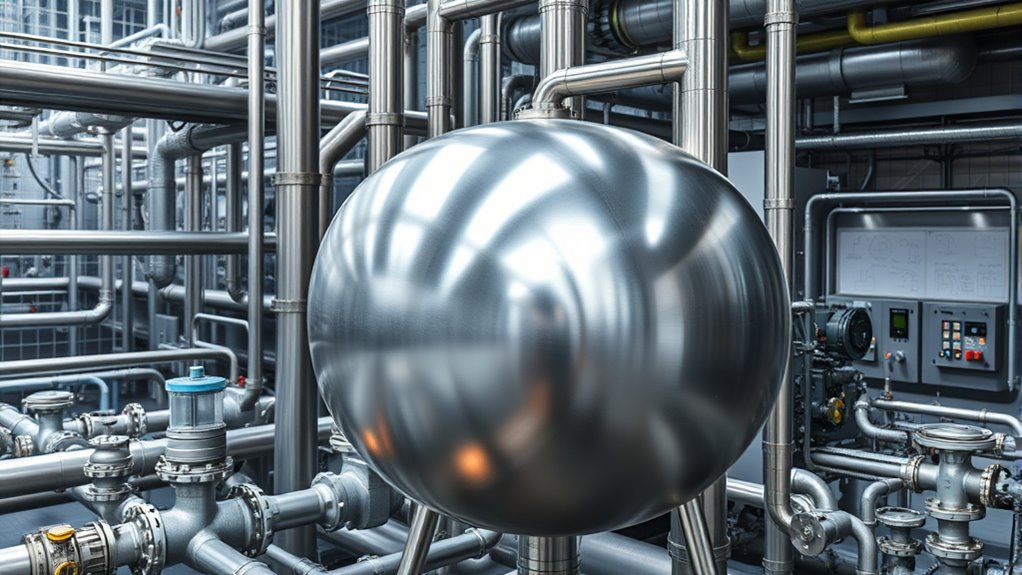
Several key factors determine the appropriate size of a surge tank, and considering these elements guarantees effective pressure management. The fluctuating flow rates within your system directly impact tank size; higher flow variations require larger tanks to absorb pressure spikes. The system’s pressure range and maximum operating pressure influence surge tank capacity, ensuring it can handle sudden pressure changes without damage. Additionally, the volume of fluid in your system, including expected surges during startup or shutdown, plays a vital role. Pump operation patterns, such as rapid startups or shutdowns, also affect sizing needs. Environmental conditions, like temperature fluctuations, can cause volume expansion or contraction, requiring adjustments. Understanding the role of pressure ratio can further help in selecting an appropriately sized surge tank to maintain system stability and prevent pressure-related issues.
Calculating the Capacity of a Surge Tank
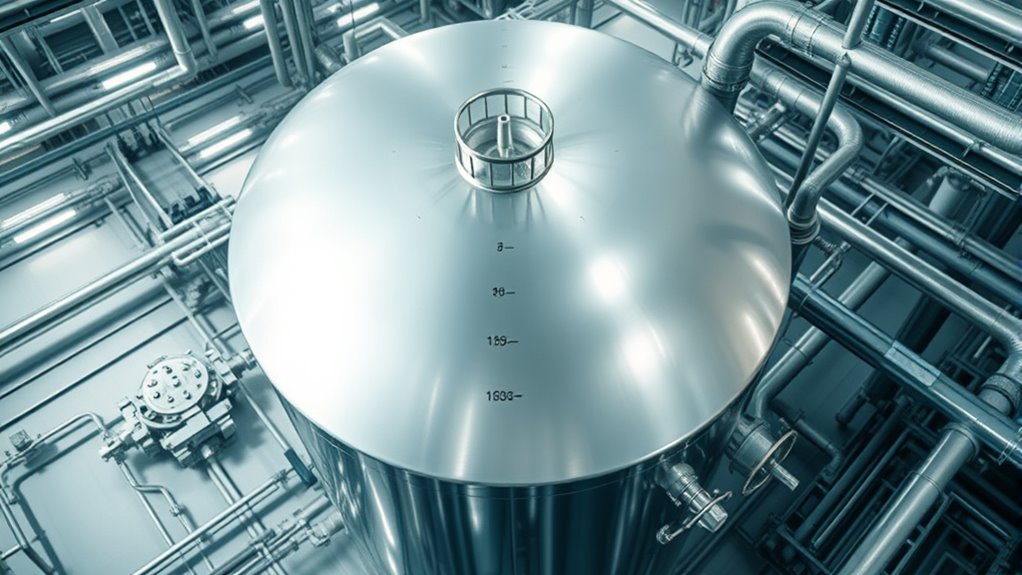
Calculating the capacity of a surge tank involves evaluating the maximum pressure variations your system may experience and determining the volume needed to absorb those fluctuations effectively. First, identify the highest and lowest pressures in your system during operation. Then, estimate the maximum flow rate changes, such as sudden valve closures or pump startups. Use these data points to calculate the volume required to accommodate pressure surges without exceeding safe limits. Typically, the surge tank should hold enough fluid to dampen pressure spikes for a set period, often a few seconds. You can use formulas based on fluid dynamics principles or consult industry standards. Making sure your surge tank has adequate capacity prevents system damage, maintains stability, and ensures smooth operation under transient conditions. Incorporating pressure fluctuation analysis into your design process helps optimize tank sizing and system resilience.
Optimal Placement Strategies for Surge Tanks
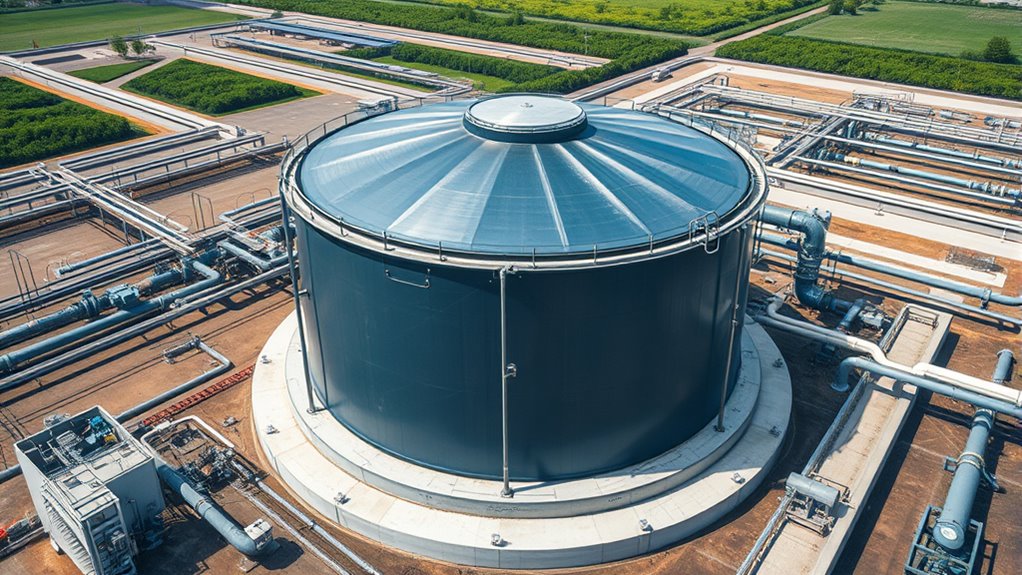
Placing a surge tank in the right location within your system can substantially improve its ability to guarantee pressure fluctuations. Typically, you should position the tank close to the pump or near high-pressure zones where pressure changes are most intense. Avoid placing it too far from these areas, as this reduces its effectiveness. Consider the flow path; placing the tank upstream or downstream where pressure surges are likely to occur maximizes its benefits. Ascertain that the tank is installed at an elevation that allows for proper pressure balancing and easy maintenance access. Also, avoid placing it in environments prone to extreme temperatures or vibrations, which can compromise its integrity. Strategic placement ensures quicker response times and more stable system operation, preventing pressure spikes and reducing stress on pipes. Understanding the pressure regulation role of surge tanks helps optimize their placement for better system stability.
Design Considerations for Effective Surge Tank Integration

Effective integration of a surge tank requires careful attention to design features that optimize its performance within your system. First, ensure the tank’s size matches your flow rates and pressure fluctuations, preventing overflow or underperformance. Second, consider the tank’s placement to minimize pressure drops and facilitate smooth flow, reducing system stress. Third, select appropriate materials that withstand operational conditions, such as corrosion or temperature variations, to enhance durability. Additionally, incorporate baffles or diffusers inside the tank to control turbulence and stabilize fluid flow. Proper venting is essential to prevent vacuum formation or pressure buildup. By focusing on these key design elements, you’ll guarantee your surge tank functions effectively, safeguarding your system against pressure surges and maintaining operational efficiency. Furthermore, understanding how automation’s role in business intelligence can assist in monitoring system performance allows for proactive adjustments and improved reliability.
Common Challenges and Troubleshooting Tips
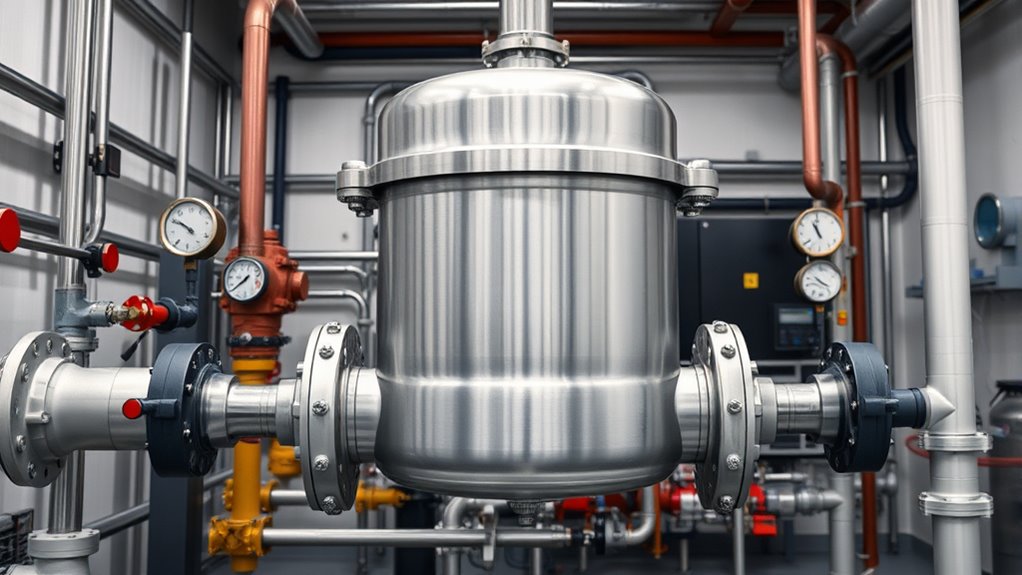
While surge tanks are designed to manage pressure fluctuations effectively, you may encounter common challenges that compromise their performance. One issue is inadequate sizing, causing insufficient pressure relief. Another is improper placement, leading to limited effectiveness during rapid pressure changes. Additionally, blockages or debris can restrict flow, reducing the tank’s ability to absorb surges. To troubleshoot, regularly check for debris, ensure correct sizing based on system demands, and verify proper installation location. Here’s a quick guide:
| Challenge | Cause | Solution |
|---|---|---|
| Insufficient pressure relief | Undersized tank | Resize or upgrade tank |
| Flow restrictions | Blockages or debris | Clean and inspect regularly |
| Poor placement | Incorrect location | Relocate tank to optimal position |
Maintenance and Inspection of Surge Tanks
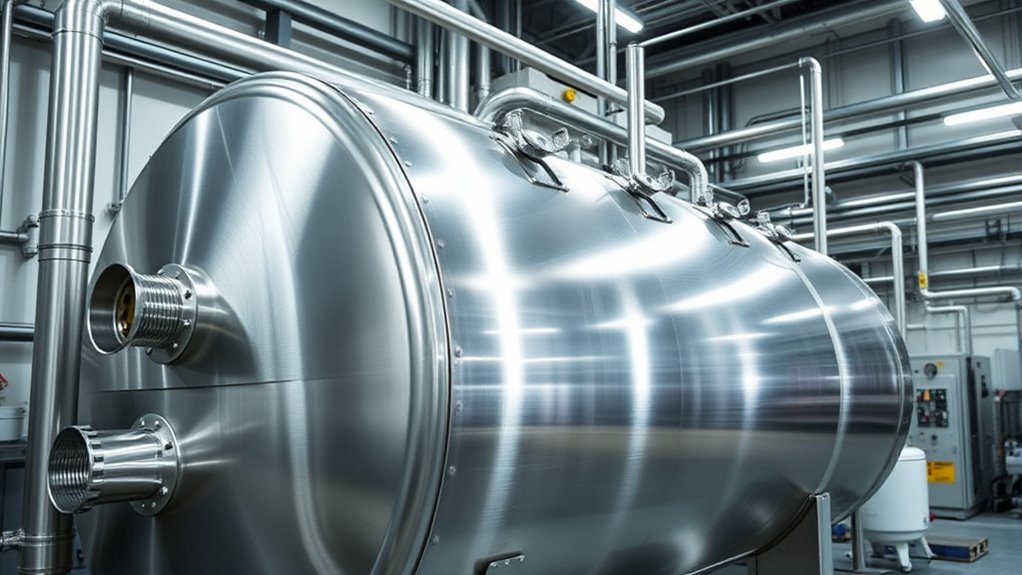
Regular maintenance and thorough inspection are essential to guarantee your surge tank functions properly and prevents system failures. By routinely checking your tank, you ensure early detection of issues that could disrupt operations. Focus on these key areas:
- Visual inspection: Look for corrosion, leaks, or damage to the tank and associated piping.
- Level and pressure checks: Ensure the tank’s water level and pressure are within specified ranges to avoid operational anomalies.
- Cleaning and debris removal: Keep the interior clean and free of debris to prevent blockages and maintain peak performance.
Perform these tasks regularly, documenting findings and addressing issues promptly. Proper maintenance reduces downtime, extends equipment life, and keeps your system running smoothly.
Case Studies Demonstrating Surge Tank Applications

Understanding how surge tanks are applied in real-world scenarios highlights their versatility and importance across different industries. For example, in hydroelectric power plants, surge tanks prevent pressure spikes during rapid water level changes, safeguarding turbines and pipelines. In oil and gas pipelines, they absorb sudden pressure surges caused by valve closures or pump startups, reducing pipe damage risks. Water treatment facilities use surge tanks to manage flow variations, ensuring consistent water quality and system stability. Chemical plants incorporate surge tanks to handle fluctuations during processing, maintaining safety and efficiency. These case studies demonstrate that surge tanks are essential for protecting infrastructure, enhancing safety, and optimizing system performance across diverse applications. Their strategic placement and sizing directly influence operational reliability and longevity.
Frequently Asked Questions
What Are the Environmental Impacts of Installing a Surge Tank?
Installing a surge tank can impact the environment through potential leaks or spills, which may contaminate soil and water sources. Construction activities might disturb local ecosystems and generate noise and dust. Additionally, materials used in the tank could pose disposal challenges. To minimize these impacts, you should guarantee proper installation, regular maintenance, and environmentally friendly practices, like spill containment and leak detection systems, to protect surrounding ecosystems.
How Do Surge Tanks Interact With Other Control Systems?
You’ll find that surge tanks actively interact with control systems by providing pressure stabilization and flow regulation. They send signals to controllers to adjust pump speeds or valve positions, preventing pressure spikes or drops. This collaboration ensures system stability, reduces stress on equipment, and enhances safety. By integrating with sensors and automation, surge tanks help maintain ideal operation, making your process more reliable and efficient.
What Are the Cost Considerations for Surge Tank Installation?
When considering surge tank installation costs, you should factor in equipment expenses, installation labor, and ongoing maintenance. You’ll need to budget for the tank itself, supporting structures, and any necessary control systems. Keep in mind that proper placement and sizing can reduce long-term operational costs by preventing system issues. While initial costs might seem high, investing in quality installation and materials can save you money on repairs and downtime later.
How Does Fluid Velocity Affect Surge Tank Performance?
Fluid velocity directly impacts surge tank performance by influencing pressure fluctuations and system stability. Higher velocities cause greater pressure surges and turbulence, reducing the tank’s ability to dampen sudden changes. Conversely, lower velocities allow for smoother flow and better absorption of pressure spikes. You should monitor and control fluid velocity to optimize surge tank effectiveness, ensuring it maintains system stability and prevents damage caused by rapid pressure variations.
Can Surge Tanks Be Used in Renewable Energy Systems?
Yes, surge tanks can be used in renewable energy systems, especially in hydropower and geothermal setups. They help manage pressure fluctuations caused by variable energy production, preventing damage to equipment. By absorbing sudden changes in flow or pressure, surge tanks guarantee system stability and safety. You’ll find them essential in maintaining smooth operation, reducing stress on pipes and turbines, and optimizing overall system performance in renewable energy applications.
Conclusion
Understanding surge tanks is essential for maintaining fluid system stability. Proper sizing and placement can reduce pressure surges by up to 80%, preventing costly damages and system failures. By following best practices and regular maintenance, you guarantee reliable operation and longevity of your infrastructure. Remember, nearly 60% of pipeline failures are linked to pressure-related issues that surge tanks can effectively mitigate, highlighting their critical role in fluid system safety and efficiency.

